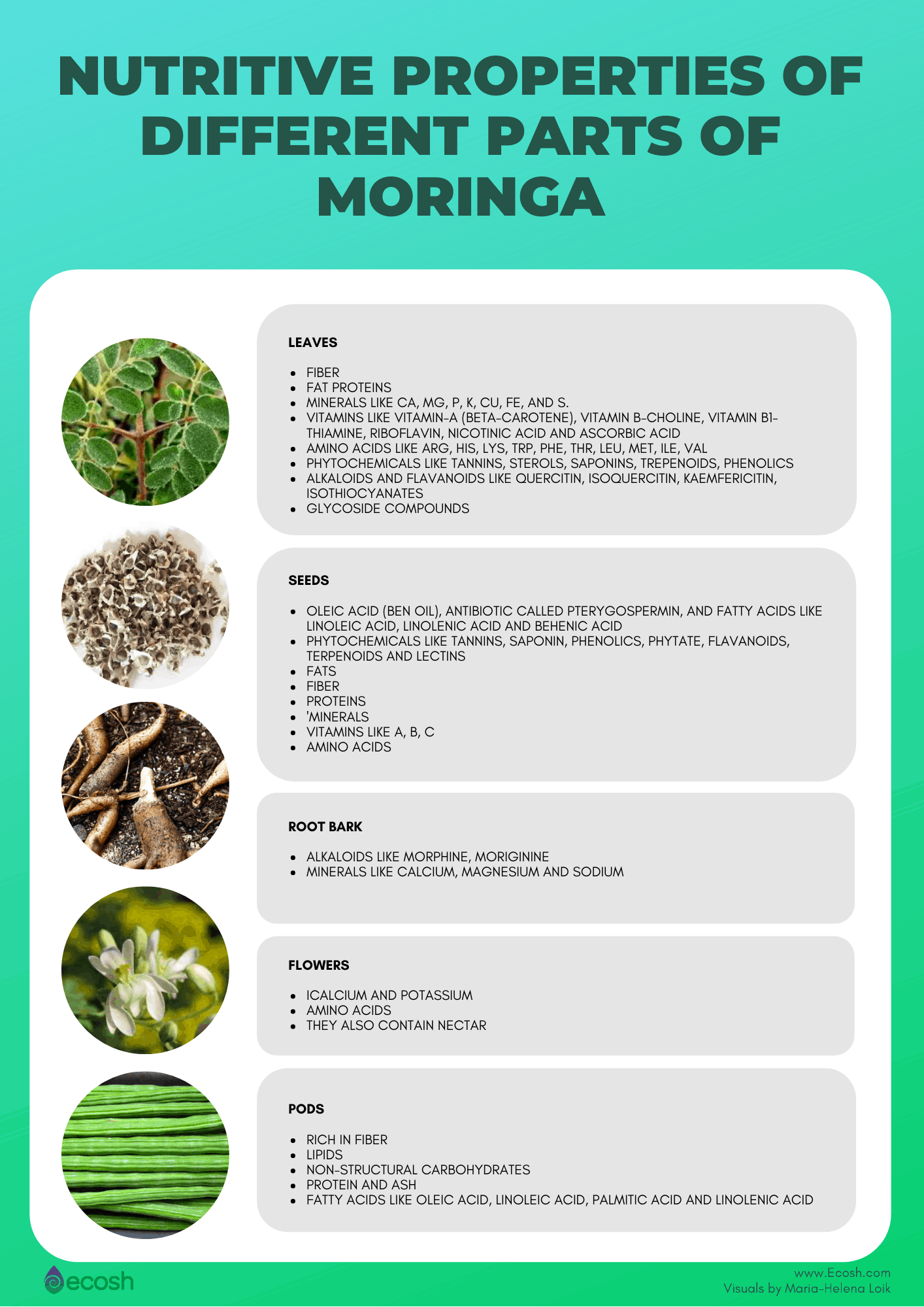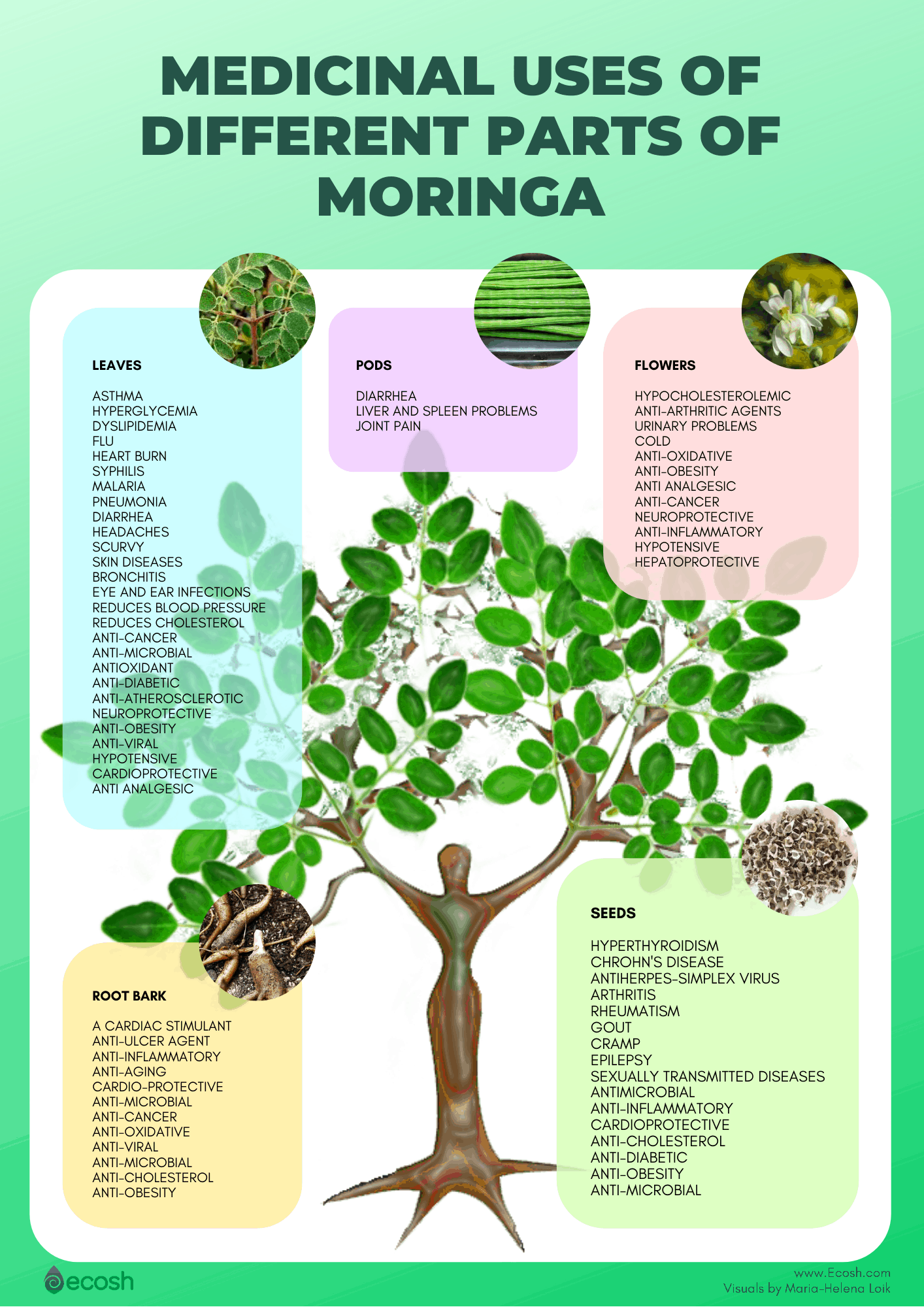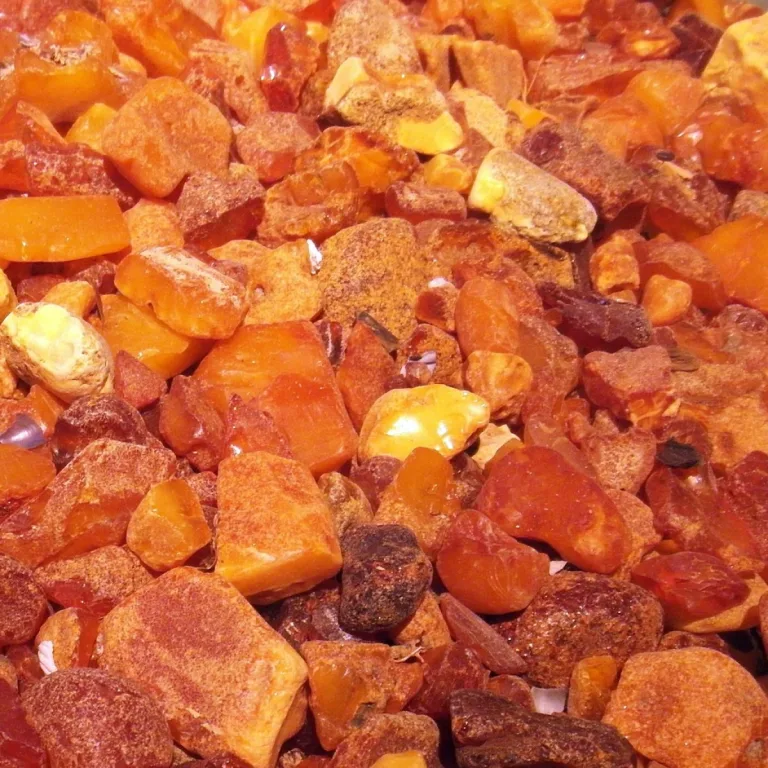Moringa Oleifera is a plant that has been highly valued for thousands of years for its healing effects. This deciduous tree comes from the southern slopes of the Himalayas in northwestern India. In addition to India, moringa is cultivated in Africa, Mexico, northern South America, Latin America, the Philippines and elsewhere.
Hence, over time, people have learned to use all parts of the plant in both culinary and traditional medicine.
Due to its special taste, functions and appearance, the plant has also been given other names, such as the horseradish tree, the drumstick tree, the ben oil tree or benzolive tree and moringa.
Moringa Oleifera is great for vitality and energy. Therefore, this superplant is used for the prevention and treatment of several diseases, and in today’s fast-paced and stressful life, it is good to help yourself with a chemical-free natural antidepressant and an excellent tonic plant. As a result, in folk medicine, moringa bark, roots, leaves, flowers, seeds, oil, juice and gum are used.
The products and different parts of this tree have been used for various diseases such as rheumatism, epilepsy, heart disease, blood pressure disorders, indigestion, skin inflammation, fever, headache, cancer etc.

Moringa in Folk Medicine
The moringa root has also been used in folk medicine to promote urinary excretion. Similarly, the seeds have been thought to help with constipation and expel intestinal parasites.
In addition, moringa plant has a strong antimicrobial and anti-inflammatory effect.
In Ayurvedic medicine, moringa trees are also valued, and its products are recommended for the prevention and treatment of 300 diseases. This superpalnt is highly rich in nutrition.
In fact, it is mentioned, that moringa contains:
25 x more iron than spinach,
17 x more calcium than milk,
15 x more potassium than bananas,
10 x more vitamin A than carrots,
9 x more protein than yoghurt,
and 7 x more vitamin C than oranges.

Moringa Nutrition Value
Moringa is very rich in antioxidants, fiber and bioactive compounds that regulate, activate and accelerate the body’s metabolic processes. Also, in addition to antioxidants, moringa leaves contain a wealth of essential minerals and amino acids.
Even more, it is precisely due to its wide range of uses, high nutrient content and healing power that this plant has become known as the Miracle tree, which is recommended to be added to any food or drink without heating to increase its nutritional value.
Moringa Contains in Total:
- 92 nutrients including vitamins, minerals, amino acids, fats, sterols, alcohols, ketones, acids, alkaloids and flavonoids.
- 46 antioxidants
- 36 anti-inflammatory agents
- 18 amino acids
- 9 essential amino acids

Antioxidants
Antioxidants are substances that inhibit and regulate the formation of free radicals. Also, there is a balance between antioxidants and free radicals throughout the body.
However, when the balance of free radicals gets disturbed, they become dangerous to the body and can cause oxidative stress.
Above all, the function of antioxidants and anti-inflammatory agents is to break the chain reactions initiated by free radicals in order to prevent the development of inflammatory processes and diseases. Read more about the damages and diseases caused by free radicals here.
Therefore, the 46 antioxidants and 36 anti-inflammatory substances contained in Moringa are a gift to the body to control, prevent and even treat various diseases.
The most important antioxidants are vitamins C, A, E, carotenoids, flavonoids, ubiquinones (Q10), selenium, manganese and zinc. Antioxidants are needed to accelerate the recovery and healing of damaged cells and tissues.

Moringa Contains Following Antioxidants:
- 3-Hydroxy-4-(α-l-rhamnopyranosyloxy)
- 3-O-(6’-O-oleoyl-β-d-glucopyranosyl)-β-sitosterol
- 4-(2/3/4′-O-acetyl-α-l-rhamnopyranosyloxy)
- 4-(4’-O-acetyl-α-l-rhamnosyloxy)
- 4-(α-l-rhamnopyranosyloxy)-benzylglucosinolate
- 4-(α-l-rhamnosyloxy)
- 4-(β-d-glucopyranosyl-1→4-α-l-rhamnopyranosyloxy)
- 4-O-(α-l-rhamnosyloxy)
- Aminopolycarboxylic acids
- Ascorbic acid (vitamin C)
- Benzyl isothiocyanate
- Niazirin
- Benzyl carmate
- Benzyl thiocarboxamide
- Butylated hydroxytoluene (BHT)
- Benzyl glucosinolate
- Caffeic acid
- Calcium
- Catechin
- Chlorogenic acid
- Cinnamic acid
- Citric acid
- Ellagic acid
- Epicatechin
- Ferulic acid
- Gallic acid
- Glucoiber
- Glucoraphanin
- Glucose oxidase
- Glucosinalbin
- Glycerol-1-1-(9-octadecanoate)
- Hydroxyanisole (BHA)
- Kaempferol
- Moringine
- Niazimicin
- O-ethyl-4-(α-l-rhamnosyloxy)
- P-Coumaric acid
- Polyphospages
- Potassium
- Propyl gallate
- Protocatechuic acid
- Quercetin
- Reduced glutathione
- Strophanthidin
- Tertiary-butylhydroquinone
- Vanillin
- Vitamin E (tocopherols)
- Β-carotene
- Β-sitosterol-3-O-β-d-glucopyranoside
In Conclusion, 1 Gram Moringa Vegetable Powder Contains:
- 25 x more iron than spinach
- 15 x more potassium than bananas
- 4 x more protein than egg
- 10 x more vitamin A than carrots
- 17 x more calcium than milk
- 7 x more vitamin C than oranges

30 Health Benefits of Moringa
The physical benefits include:
- Protects and nourishes skin and hair. Because of the content of protein, hydrating and also detoxifying elements, this plant protects skin cells from damage and promotes healthy skin and hair.
- Similarly cures skin infections and sores.
- Also reduces wrinkles.
- Stimulates hair growth.
- Above all moringa has anti-inflammatory properties.
- Treats edema (because of anti-inflammatory properties).
- Protects the liver.
- Helps to detoxify the body from waste products.
- Has anti cholesterol properties.
- Most noteworthy, moringa prevents and treats cancer, because it contains niazimicin, which suppresses the development of cancer cells.
- Helps to suppress appetite.
- Increases energy and endurance.
- Improves digestion.
- Eliminates constipation.
- Treats stomach complaints such as gastritis, and ulcerative colitis. High vitamin B content in moringa helps with digestion, and the antibiotic and antibacterial properties may help inhibit the growth of various pathogens.
- Strengthens the immune system.
- Fights against bacterial diseases caused by Salmonella, Rhizopus, and E. coli. It’s because of its antibacterial, antifungal, and antimicrobial properties.
- Makes bones healthier, so moringa may treat arthritis and also heal damaged bones. Because of the calcium and phosphorus content, moringa helps keep bones healthy and strong.
- Protects the cardiovascular system. Due to the high antioxidants content, moringa might help prevent cardiac damage and maintain a healthy heart.
- Also used as aphrodisiac and promotor of libido.
- Has antioxidant properties.
- Helps wounds to heal.
- Treats diabetes, helps to reduce the amount of glucose in the blood, as well as sugar and protein in the urine. Improves the hemoglobin levels and overall protein content.
- Treats asthma, can help lungs function better and overall breathing.
- Also protects against kidney disorders.
- Furthermore, reduces high blood pressure.
- Improves eye health.
- Finally, treats anemia and sickle cell disease. It’s because moringa helps the body absorb more iron, therefore increasing the red blood cell count.
The mental benefits include:
- Treats mood disorders and increases mental clarity.
- Helps in case depression, anxiety, and fatigue.
Compiled and edited by Maria-Helena Loik
Sources: Medicalnewstoday.com, Amchara.com, Sciencedirect.com
Pictures: Pexels.com, Pixabay.com, Shutterstock.com


